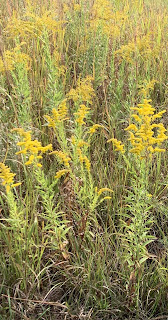Hi, Everyone! I apologize for the long lapse in posting, but autumn has been moving along and the world is streaming past my eyes at the speed of life.
Both Mrs. ProfessorRoush and I agree (for once) that this fall has been a colorful one in Kansas; despite the national media predicting poor autumn displays in the usual tourist spots, we've been fortunate here. As you can see from the back yard, photographed above last Wednesday, the prairie grass has great color this year and the garden is settling in and ready for cold. And the cold is coming this week, lows down to 30º, highs in the 50's. We should finally see a fairly hard freeze to shut down the final growth mania.
I hope, however, that this
Aster frikartii ‘Flora’s Delight’ somehow survives the frosts. I don't believe I've mentioned it before, but it's been a garden stalwart since 2004. I seldom pay this plant much positive attention until now, when it lights up a corner of my front bed to the right of the sidewalk. I spend most of the spring ripping it out and keeping it within a 6 foot diameter area. It's one of those plants which should come with a hazardous warning label, but most web sources about it only suggest that it makes a good "container" plant. Oh, yes it does, because if it isn't in a container it makes a fairly tall invasive groundcover to about a foot high! By July, however, it stops being a bother and I forget all about it.
I forget about it until now when those soft lavender blue blooms highlight those bright yellow centers and catch my eye.
Aster frikartii is also attractive to bees and is probably one of their last source of nectar before winter. This cold bumbler stood fairly still for the camera, not moving until I almost touched it. And now I feel guilty because I should have let this aster spread and bloom more; for the bees, you see.
We finally, finally received a nice rain this week, about 3.6 inches total over a long night and day of rain, so I hope the garden will go into another Kansas winter well-hydrated and ready to rest.
And I hope the garden stops the weird antics that fall sometimes brings. I've been worried about the row of lilacs to the west of the driveway pad. Several of them, primarily the older
Syringa vulgaris, have leafed out some of those precious green buds after they dropped their summer leaves and a couple even bloomed, like this 'Nazecker' light blue lilac. I won't minimize the sublime joys of smelling lilacs in October, but I also don't need to constantly feel like they've sacrificed their last for me. I suppose the chance always exists that I won't be around to smell lilacs next spring, but I'm planning to be here when the snows melt and the lilacs bloom next April, the world right and everything in its own time, just as it should be.














